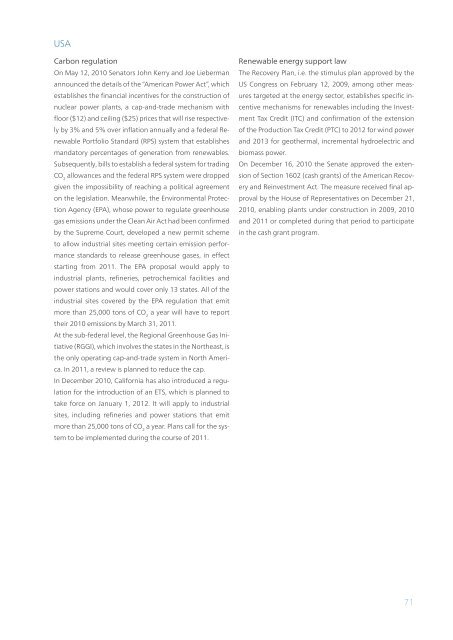Annual Report 2010 - Enel.com
Annual Report 2010 - Enel.com
Annual Report 2010 - Enel.com
You also want an ePaper? Increase the reach of your titles
YUMPU automatically turns print PDFs into web optimized ePapers that Google loves.
USA<br />
Carbon regulation<br />
On May 12, <strong>2010</strong> Senators John Kerry and Joe Lieberman<br />
announced the details of the “American Power Act”, which<br />
establishes the financial incentives for the construction of<br />
nuclear power plants, a cap-and-trade mechanism with<br />
floor ($12) and ceiling ($25) prices that will rise respectively<br />
by 3% and 5% over inflation annually and a federal Renewable<br />
Portfolio Standard (RPS) system that establishes<br />
mandatory percentages of generation from renewables.<br />
Subsequently, bills to establish a federal system for trading<br />
CO allowances and the federal RPS system were dropped<br />
2<br />
given the impossibility of reaching a political agreement<br />
on the legislation. Meanwhile, the Environmental Protection<br />
Agency (EPA), whose power to regulate greenhouse<br />
gas emissions under the Clean Air Act had been confirmed<br />
by the Supreme Court, developed a new permit scheme<br />
to allow industrial sites meeting certain emission performance<br />
standards to release greenhouse gases, in effect<br />
starting from 2011. The EPA proposal would apply to<br />
industrial plants, refineries, petrochemical facilities and<br />
power stations and would cover only 13 states. All of the<br />
industrial sites covered by the EPA regulation that emit<br />
more than 25,000 tons of CO a year will have to report<br />
2<br />
their <strong>2010</strong> emissions by March 31, 2011.<br />
At the sub-federal level, the Regional Greenhouse Gas Initiative<br />
(RGGI), which involves the states in the Northeast, is<br />
the only operating cap-and-trade system in North America.<br />
In 2011, a review is planned to reduce the cap.<br />
In December <strong>2010</strong>, California has also introduced a regulation<br />
for the introduction of an ETS, which is planned to<br />
take force on January 1, 2012. It will apply to industrial<br />
sites, including refineries and power stations that emit<br />
more than 25,000 tons of CO a year. Plans call for the sys-<br />
2<br />
tem to be implemented during the course of 2011.<br />
Renewable energy support law<br />
The Recovery Plan, i.e. the stimulus plan approved by the<br />
US Congress on February 12, 2009, among other measures<br />
targeted at the energy sector, establishes specific incentive<br />
mechanisms for renewables including the Investment<br />
Tax Credit (ITC) and confirmation of the extension<br />
of the Production Tax Credit (PTC) to 2012 for wind power<br />
and 2013 for geothermal, incremental hydroelectric and<br />
biomass power.<br />
On December 16, <strong>2010</strong> the Senate approved the extension<br />
of Section 1602 (cash grants) of the American Recovery<br />
and Reinvestment Act. The measure received final approval<br />
by the House of Representatives on December 21,<br />
<strong>2010</strong>, enabling plants under construction in 2009, <strong>2010</strong><br />
and 2011 or <strong>com</strong>pleted during that period to participate<br />
in the cash grant program.<br />
71









